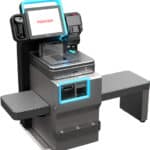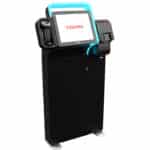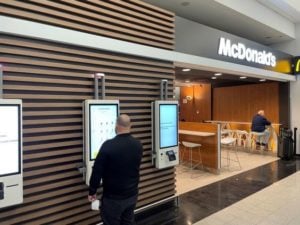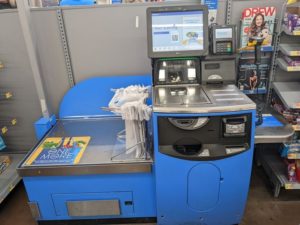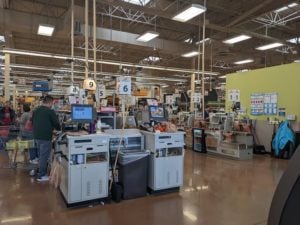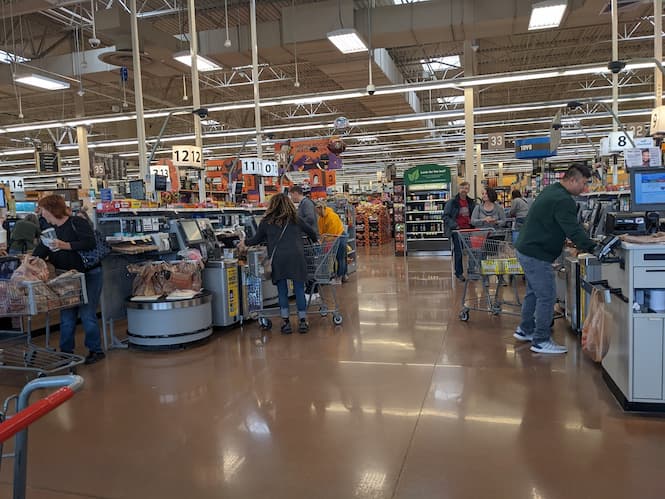
Disabled Shoppers Struggle With Inaccessible Self-Checkouts
Dec 1, 2022 – New article from Wall Street Journal (WSJ) on inaccessible self-checkouts. Blind people, wheelchair users and others say the design of typical self-service machines prevents them from shopping independently. By Katie Deighton — we continue to see major media taking the “increase our viewership” tactic by less than accurate article critical of self-checkout. Latest example is the Guardian article on “not living up to promise” [thanks Ross Tocher].
Update: See our post on another article by by Food Institute. Includes comments from Toshiba, Storm Interface and also Kiosk Association. One distinction that we like to make is that self-checkout at grocery stores is closely aligned with Point Toshiba kiosk of Sale terminals and in fact are truly just hybrid customer-facing POS terminals or platforms.
You can see on the Toshiba site how they categorize their self-service offerings with three iterations one of which is what we call a standup kiosk. The “warts” which are the POS terminals attached to these are almost always the complicating factor. Money transfers have that effect. We are impressed with Toshiba responding. You might think NCR would respond but probably they have their hands full right now in the middle of their reorganization of retail and financial divisions (the financial division being banks and ATMs generally).
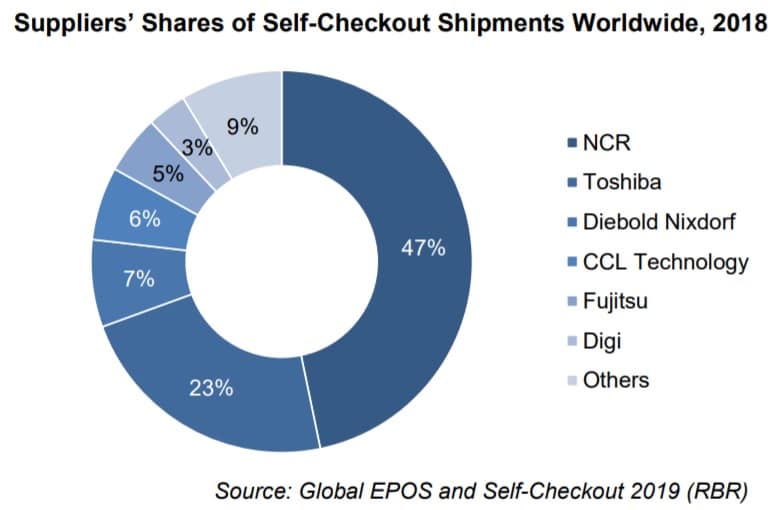
grocery store self-checkout
Summary In Brief
- Good to see continued awareness
- RBR, who counts NCR and Toshiba as clients, estimates rising shipments
- 2018 – 80,000
- 2019 — 141,000
- 2021 – 200,000
- Not sure how many new, how many replacements
- Speed is the main driver
- Pretty weird health justification. You are definitely more vulnerable in self-checkout than you are in a line with clerk, at least when it comes to airborne which is 10X the factor of surfaces touched.
- Picture of Marks and Spencer and actions they tool
-
McDonalds in an airport. Are these employee assisted? Look like standard Verifone terminals.
NFB Hackert recommends headphone jack, screen-reader sw and tactile keyboard
- Hackert puts the responsibility on the vendors providing the kiosks
- Fast-food restaurants should offer unassisted accessibility
- Academic explains kiosk purchase process
- The article quotes — In the U.S., regulations concerning technological accessibility don’t specifically cover self-service checkouts and kiosks. And ATMs are standard.
- Walmart 2018 legal victory in Maryland with staff assistance is referenced (nothing about 2017 California verdict against)
- Eve Hill comments on privacy and she is always good to hear from
- Article closes with pointing to U.S. Access Board future actions.
Our Take?
- Accessibility only matters to most when there is payment involved.
- Despite its gated accessibility for articles, the WSJ is still a welcome communicator of accessibility issues.
- It’s unfortunate that it is the Walmarts and Krogers (in the US) do not feel the imperative to demand better accessibility engineering from vendors like NCR and Toshiba. Maybe they do in California where the Unruh Act has already bit Walmart.
- Probably, the occasional settlement these companies pay is relegated to the cost-of-doing-business accounting column (much like casinos). FOBS or Fear of Being Sued is reserved for SMB which do not drive that market.
- Headphone jacks are fine, as long as they work and many don’t, especially in the ATM world
- There are regulations (operable parts for example) that are applied to kiosks.
- There is a big difference between “regulations covering” and “regulations enforced”. Take a look at compliance at the federal and state level where Section 508/etc is absolutely mandated.
- Regulations in the private retail space are decidedly different than in the federal and state space but enforcement remains low in both.
-
Those same POS devices which are used in unattended are most times not certified by PCI SSC for unattended cardholder data (aka CAT or Cardholder Activated Transaction). The large retail chains want economies of use by using the same device across attended and unattended and figuratively “twist the arm” of the POS provider to provide conditional exceptions on liabilities. That reduces provisioning costs and service costs for them.
- You have to wonder how McDonalds deploys non-CAT certified POS devices “outside” their restaurant (airport terminal e.g.)
- These are NOT kiosks. They are hybrid POS customer-operated. Lots of them on counters at stores where you “swipe” your card.
- Too often these articles leave the impression that there is some essential kiosk that everybody sells.
- The buying and deploying companies issue their RFP with requirements laid out.
- The vendors recommend adding accessibility options.
- The buying and deploying companies check with bean counters and budget
- They decline the additional options
- Another real-life example is the AT&T Bill Payment machine. The POS device is mounted out of ADA spec, and at the insistence of AT&T we think because some marketing person thought “it looks better at that angle”.
- It’s noteworthy that authorities in the kiosk industry are never interviewed for these articles or the POS providers for that matter (which are always the key trigger point). Consultants and academics have their own vested interests and to a large extent the term “kiosks” is used almost as a deflection. Simplifying the equation, it is mostly a touchscreen in tandem with POS device.
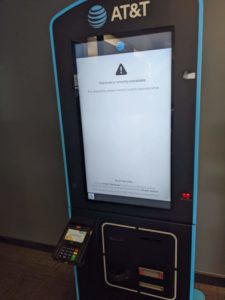
AT&T PAYMENT KIOSK
Blind people can have trouble navigating the touchscreens. Deaf people might not be able to troubleshoot on kiosks that connect to a customer-service worker located somewhere else. And wheelchair users sometimes can’t reach or see the screens, or fit their chairs comfortably in the space allocated to each checkout.
“Why should I have less choice on how I check out my shopping just because I have one leg and I’m in a wheelchair?” said Lyndsay Watterson, an above-the-knee amputee who lives in the U.K. and has founded Neo Walk, a maker of fashion-forward walking sticks.

Self-Checkout – click for full size
“I don’t want to go to a staffed checkout because I’m still vulnerable to catching infections, and I don’t want someone else handling my stuff,” she said. “[Self-checkout] just cuts out that extra person that you’ve got to interact with.”
Comments
- So given all these reasons to not use self-checkout at grocery, why is it flourishing?
- The biggest reason companies are deploying Self-Checkout now is that they cannot get enough employees to run their stores. COVID helped move the trend further, but retailers must do more with less. There are 3 million fewer retail workers than we had pre-COVID, but 10,000 new stores. So self-checkout helps retailers move employees to other functions like Click and Collect, preparing meals, and picking digital orders. This is just one technology of many that retailers are deploying to help redeploy labor and lower costs. — Greg Buzek of IHL Services
Related Links
- https://www.lflegal.com/2021/10/kiosk-maryland-opinion/ – Lainey Feingold take on Walmart 2021
- 2021-legal-walmart-NFB-
NFB10122021opinion.pdf - Whitepaper – Walmart and ADA Settlement in California 2017
- Walmart settles disability-rights suit over payment machines
Media Tracker
- Here are some examples of “beating up self-checkout” by major media looking to entertain and increase viewership. https://www.theguardian.com/business/2022/dec/16/self-checkout-us-retail-walmart — [thanks to Ross Tocher]
- 2019 Article on Walmart using AI-powered cameras at checkout areas –This was the last AI+Walmart item to appear though since then none except use of AI and restocking shelves for Walmart Canada.
- Mashgin (7000 units?) is rolling out with Circle K but these are not high volume grocery store self-checkouts.
- Retailwire Nov 2022 — Headline: Have grocery self-checkouts been designed to disappoint? — In recent months we have read Wegmans announce that it is pulling its self-checkout technology because of concerns over theft; Tesco is facing customer displeasure with its self-checkouts; Albertsons is redeploying self-checkout after an eight-year hiatus; Kroger added Everseen’s Visual AI to its self-checkout POS; and Walmart wants to eventually have all cashier-less stores. The direction of self-checkout is varied.
- Nice set of sublinks for more reading
- Shoplifters force Wegmans to pull the plug on its self-scanning app – RetailWire
- Tesco Faces Backlash Over Introduction of More Self-Service – Grocery Gazette
- Nobody likes self-checkout. Here’s why it’s everywhere – CNN/WISHTV.com
- Shaping Kroger’s Self-Checkout of Tomorrow with AI and Edge Computing – Lenovo StoryHub
- Walmart Is Looking to Remove All Cashiers From Stores, Going Fully Self Checkout – Positively Osceola

